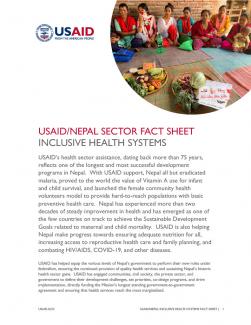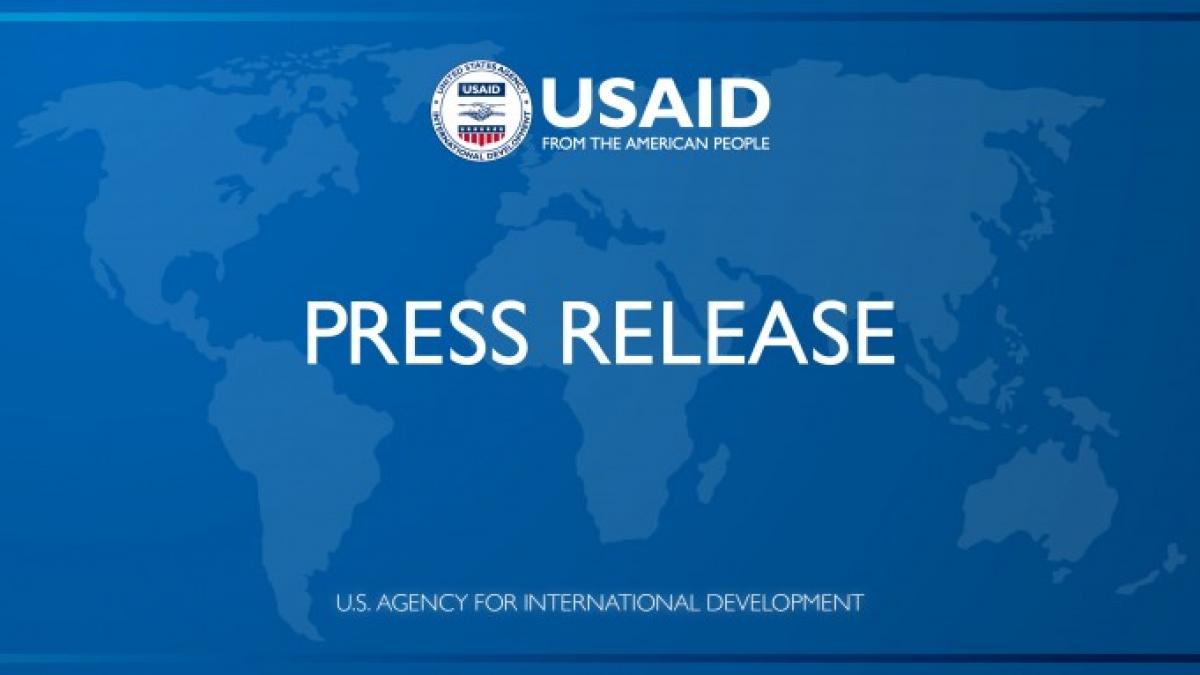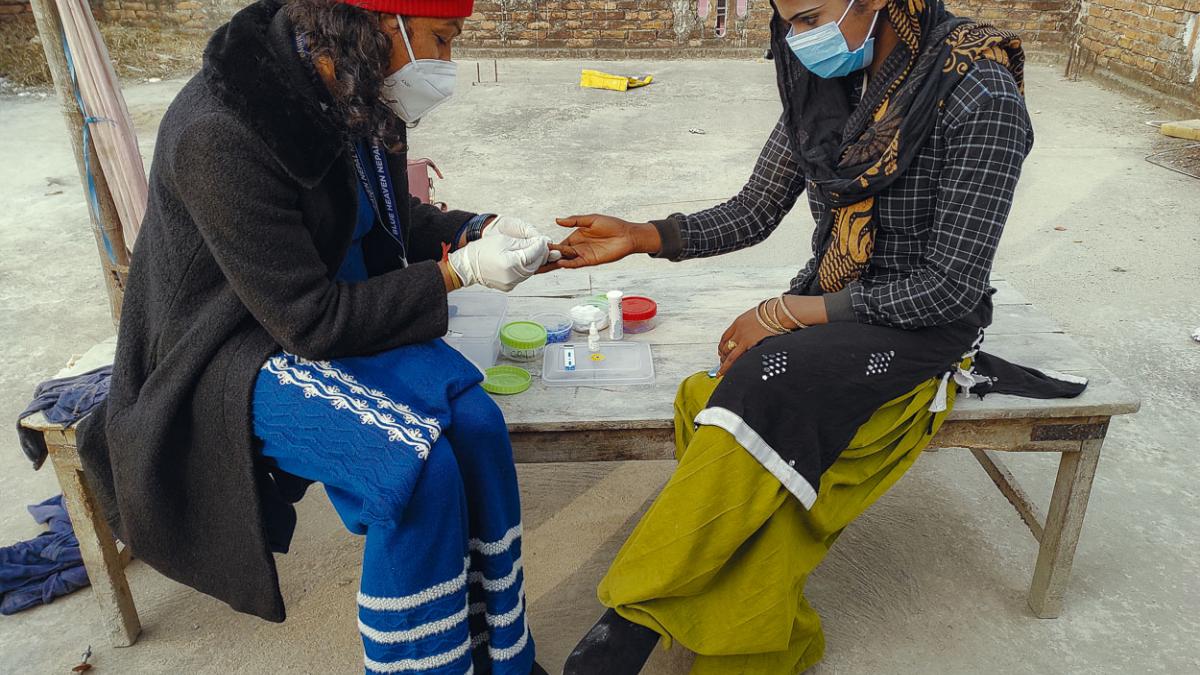Health Office Sector Fact Sheet
$330 Million in Current Activity Funding
USAID’s support in the health sector, dating back more than 75 years, reflects one of the longest standing and most successful development assistance programs in Nepal. With USAID support, Nepal all but eradicated malaria, proved to the world the value of Vitamin A supplementation and chlorhexidine use for infant and child survival, and launched the successful model of female community health volunteers to provide hard-to-reach populations with basic preventive health care. With USAID support, Nepal has experienced more than two decades of steady improvement in health and has emerged as one of the few countries on track to achieve the Sustainable Development Goals related to maternal and child mortality. USAID is also helping Nepal make progress towards ensuring adequate nutrition for all, increasing access to reproductive health care and family planning, and combating HIV/AIDS, COVID-19, and other diseases.
USAID has helped equip the different levels of Nepal’s government to perform their new roles under federalism, ensuring the continued provision of quality health services and sustaining Nepal’s historic health sector gains. USAID has engaged communities, civil society, the private sector, and government to define their development challenges, set priorities, co-design programs, and drive implementation, directly funding the Mission’s longest standing government-to-government agreement and ensuring that health services reach the most marginalized
Quality Public Health Services
USAID has a strong and collaborative partnership with the Government of Nepal (GoN) to improve the survival and quality of life of all Nepalis. USAID health programs employ an integrated approach to improving maternal, newborn, and child health, nutrition, and air quality. USAID also implements programs on water, sanitation and hygiene (WASH), that provide rehabilitation support for those with disabilities, HIV prevention and treatment, and family planning and reproductive health services. USAID supports Nepal’s response to infectious diseases such as COVID-19 and polio. Aligned with the GoN’s health strategy, USAID builds on existing efforts to address the needs of women, girls, and other vulnerable groups, promoting research, and engaging other donors and civil society in health.
Access to Health Services
USAID strengthens communities’ engagement with their health institutions to ensure that the concerns of marginalized and disadvantaged groups are addressed and to hold leadership and providers accountable for delivering quality health services. USAID mobilizes frontline health workers to create demand for maternal newborn, child health, nutrition and family planning services in 387 municipalities of Nepal. In 138 municipalities of Karnali and Lumbini provinces, USAID engages with municipalities to ensure that marginalized populations have access to high quality, basic health services. Additionally, USAID’s activities support Nepal’s most vulnerable populations such as those living with disabilities or HIV, to ensure equitable access to critical services such as physical rehabilitation and antiretroviral therapies.
Health Systems that can withstand shocks
USAID assisted 138 municipalities to respond to the COVID-19 pandemic. This included critical improvements to Nepal’s health system to be able to test, treat, and prevent the spread of COVID-19 through behavior change and vaccine roll out. At the community level, USAID programs have provided essential information on disease prevention and countering virus misinformation. . USAID also provided critically needed vaccines, personal protective equipment, ventilators, oxygen generating systems, and other lifesaving equipment and commodities. Through USAID’s support through the pandemic, Nepal has achieved a 97% vaccination rate (among 12 years and above) and the health system is better equipped and trained for additional shocks that may emerge.
Impact/Results:
USAID, in cooperation with the Government of Nepal and other donors, has helped Nepal bring down the number of maternal deaths by nearly 70% since 1990, as well as significantly reduce under-5 child mortality by more than 67% over the past 20 years (Nepal Demographic and Health Surveys [NDHSs]).
With USAID support, Nepal has demonstrated a sustained reduction in stunting from 57% in 1996, to 36% in 2016 (NDHSs).
USAID’s contributions on improving health services such as development of skilled birth attendants and use of uterotonics, resulted in increasing institutional birth to 58% in 2016 from a mere 9% in 2001 (NDHSs).
USAID support has contributed to Nepal being declared Open Defecation Free in 2019 and 95% of households using improved sanitation methods (Nepal Multiple Indicator Cluster Survey [NMICS] 2019).
With USAID support, Nepal is maintaining coverage of vitamin A supplementation over 90% among children 6-59 months. Each year, 2.7 million children receive vitamin A capsules and 2.4 million children receive deworming tablets preventing child deaths.
USAID’s support to the community-based child health programs contributed to improve care-seeking for children under five with symptoms of acute respiratory tract infection. The care-seeking for acute respiratory infections increased to 82% in 2019 from 50% in 2014 (NMICSs).
USAID’s long-standing support for Nepal’s family planning program has contributed to reducing the Total Fertility Rate from 4.1 in 2001 to 2.3 in 2016 (NDHSs). Demand for Family Planning has increased gradually from 61% in 1996 to 76% in 2016 (NDHSs).
Service delivery points providing all five temporary family planning methods (oral contraceptive pills, injectables, condom, implants and intrauterine contraceptive device) increased significantly from 17% in 2014 to 62% in 2018 in 22 USAID intervention districts.
A remarkable increase in the modern contraceptive prevalence rate (mCPR) from 40% in 2017 to 45% in 2020 is achieved in the USAID target intervention districts for social marketing.
With USAID support, Nepal is making progress towards reaching HIV epidemic control. Against the global 90-90-90 target, in 2021, Nepal was able to achieve: 87% of all people living with HIV in Nepal knowing their HIV status; 83% of all people with diagnosed HIV infection receiving sustained antiretroviral therapy; and 61% of all people receiving antiretroviral therapy have accessed viral load testing services, of those tested 96% of them achieving HIV viral suppression. In addition, Nepal’s PEPFAR program has rapidly scaled up pre-exposure prophylaxis, HIV self-testing services and completed optimization of antiretroviral (ARV) treatment by transitioning all eligible people living with HIV to a more effective treatment regimen.
In 2021, USAID supported 8,067 people with disabilities including 3,343 women, with physical therapy, psycho-social counseling, and assistive devices; supported 204 different local organizations to provide high-quality rehabilitation services; and supported 23 people with disabilities to live independently and with dignity.
*Data from FY2021
Share This Page



